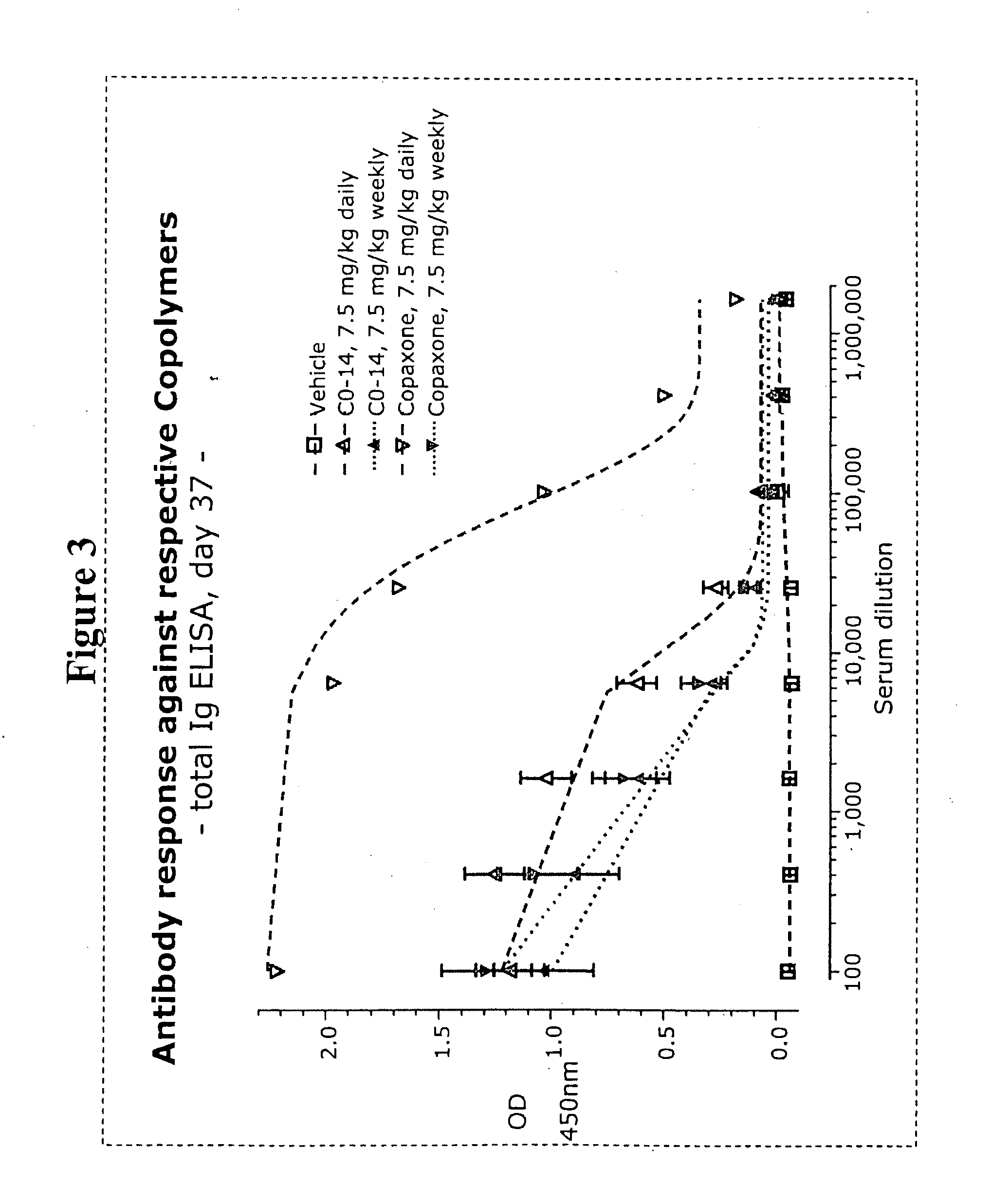Methods of treating disease with random copolymers
a random copolymer and disease technology, applied in the field of random copolymer treatment, can solve the problems of increasing the likelihood of the broadening of the offending epitope, affecting the treatment effect, so as to improve the effect of cop 1, and improve the effect of cop
- Summary
- Abstract
- Description
- Claims
- Application Information
AI Technical Summary
Benefits of technology
Problems solved by technology
Method used
Image
Examples
example 1
Production of Antibodies Against Random Copolymers and a Disease-Associated Antigen Peptide
[0237]PLP(139-151) peptide is the major immunogenic determinant recognized by CD4+ TH1 cells which in turn drive EAE development in SJL mice. When injected with pertussis toxin, PLP (139-151) peptide causes MS-like symptoms in the SJL mice. In the absence of the pertussis toxin, injected animals develop only mild and transient disease. The ability of random copolymer compositions to protect the animals from the effect of PLP injection was evaluated in the course of daily and weekly dosing of the animals after their exposure to PLP (139-151) peptide. Antibody isotypes were also examined. CD4 T cells can be divided into at least two different subsets depending on the pattern of their cytokine production. TH1 cells preferentially produce IL-2 and IFN-γ, activate macrophages, and stimulate production of the Ig subclasses IgG2a and IgG3 in mice and IgG1 and IgG3 in humans. In contrast, the signatur...
example 2
T Cell Response to Random Copolymers
[0242]The TH1 and TH2 profiles of mice injected with 5 μg Copaxone™ or Co-14 (YFAK) three times a week or on weekly bases, up to day 22 of the treatment. On day 2, 8, 9, 15, 16, 22, 23, 29, spleens were collected and splenocytes were isolated. 400,000 cells per well of splenocytes were restimulated with various concentrations (0.8, 4, or 20 μg / ml) of Co-14 (YFAK) for three days. On day 3 of the cell culture, the cells were transferred onto ELISPOT (enzyme-linked immunospot assay) plates, coated with either IFN-γ (interferon gamma) or IL-13 (interleukin 13). The T cell response is examined by measuring the IFN γ production (a TH1 cytokine) and IL-13 production (a TH2 cytokine). The degree of T cell stimulation is also examined by measuring the proliferation of the cells shown as tritiated thymidine intake.
[0243]A burst of response was seen in the first week of dosing, followed by a decreased but sustained response. As seen in FIG. 9, the response i...
example 3
Generation of Peripheral Responses to YFAK in Non-Human Primates
[0244]Twelve adult macaca fascicularis / cynomolgus monkeys (three animals per group), weighing at 2-5 kg, were administered Co-14 (YFAK) daily for fourteen days, at the dosage of 0 mg / kg (receiving mannitol), 0.2 mg / kg, 2 mg / kg, or 40 mg / kg Co-14 (YFAK) subcutaneously. Blood was drawn on days 0, 1, 8, 15, 28, and 35 into lithium heparin tubes. Red blood cells were removed using Ficoll® gradient centrifugation, and plated in round bottom 96 well plates in growth medium containing 5% serum. The cells were plated at 400,000 / well. Co-14 was added to the medium on the first day of culture at concentrations ranging from 0.2 ug / ml to 100 ug / ml. For proliferative analysis, tritium was added to the medium on day 3, and cells were harvested the next day. For flow cytometric analysis, cell were harvested on day 3 and stained with fluorescently labeled antibodies. Serum samples were taken on day-1 and day 39 and used to measure anti...
PUM
| Property | Measurement | Unit |
|---|---|---|
| molar ratio | aaaaa | aaaaa |
| time | aaaaa | aaaaa |
| time | aaaaa | aaaaa |
Abstract
Description
Claims
Application Information
 Login to View More
Login to View More - R&D
- Intellectual Property
- Life Sciences
- Materials
- Tech Scout
- Unparalleled Data Quality
- Higher Quality Content
- 60% Fewer Hallucinations
Browse by: Latest US Patents, China's latest patents, Technical Efficacy Thesaurus, Application Domain, Technology Topic, Popular Technical Reports.
© 2025 PatSnap. All rights reserved.Legal|Privacy policy|Modern Slavery Act Transparency Statement|Sitemap|About US| Contact US: help@patsnap.com



